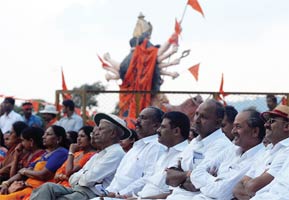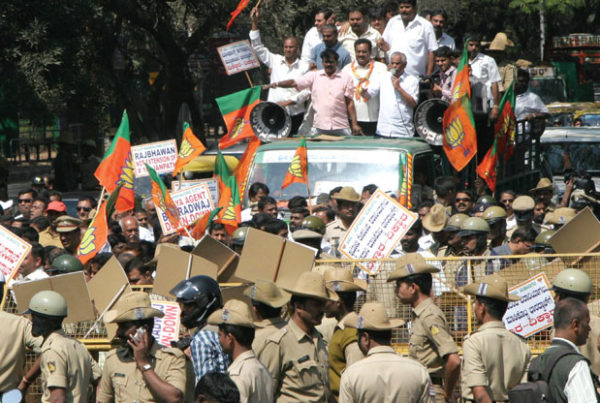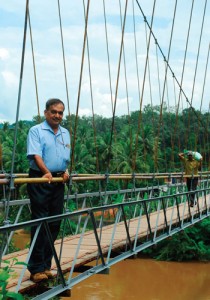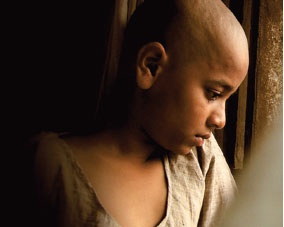 War cries: Swami Ramananda of Kolya Math addressing the Dharma Raksha Manch meeting in Madikeri. Photo: S Radhakrishna
War cries: Swami Ramananda of Kolya Math addressing the Dharma Raksha Manch meeting in Madikeri. Photo: S RadhakrishnaIT HAS been less than a year since the Bharatiya Janata Party (BJP) came to power in Karnataka on its own, marking the party’s much-touted first consolidation in south India. Since the May 2008 victory, the state has been routinely making headlines at an unprecedented rate for incidents of communal violence — not, perhaps, unexpected in the buildup to this year’s Lok Sabha polls.
What is worrying, however, is the active and increasing role played by quasi-political religious outfits functioning with the support of members of the state government at the highest levels. The most recent such formation is the Dharma Raksha Manch, launched in Mumbai on January 29, 2009 by the rightwing Vishwa Hindu Parishad (VHP). Bringing together influential Hindu holy men and religious leaders, the Manch aims to restore “the centrality of the Hindu religion to the fabric of the Indian nation and society” and to reclaim India as a Hindu country.
If the rhetoric fails to raise alarm, the events that followed a Manch meeting last month definitely do. Mangalore, the scene of the Sri Rama Sene attack on women pub goers in January, was the venue for the gathering, with the Manch morphed into the Dharma Raksha Vedike, the minor twist to the name being intended to suit the southern Indian audience. Among the politicians present were Karnataka’s Home Minister, VS Acharya; BJP state unit president DV Sadananda Gowda; MLAs Yogish Bhat and Raghupati Bhat; and the BJP candidate for the Mangalore Lok Sabha constituency, Nalin Kumar Kateel. Termed a samajotsava, or a social festival, the gathering saw a turnout of over a lakh people.
Hours after the meeting concluded and its participants dispersed, violence erupted in at least six places across Dakshina Kannada district, of which Mangalore is part, and in neighbouring Udupi. Windshields were broken and passersby attacked. One of the most serious incidents was an attack on seven boys, six Muslims and a Hindu, returning by car from a cricket tournament in Kaup in Udupi.
According to a victim, they were stopped on their way by a police constable who asked if there were any women travelling with them and, finding there were none, advised them to hurry to safety. Minutes later, the boys were mobbed by a group of saffron activists who, on seeing an Islamic religious sticker on the car’s windshield, smashed it and attacked its passengers. The lone Hindu was not spared. He was punished for calling Muslims his friends.
In another incident, a van carrying members of a Muslim marriage party in the Kaup highway in Udupi was stoned, leaving some of the women passengers seriously injured. The group fled to the safety of a nearby mosque with the mob in pursuit. The arrival of police aggravated the situation. Witnesses claim police fired teargas shells not at the crowd outside the mosque but the people inside. Shockingly 27 Muslims who had sought shelter inside the mosque were arrested and charged with serious offences including attempt to murder. “They fired without the slightest consideration for people. And that too only in the direction of Muslims,” says Hameed Abdul Qadar, the president of the Jama Masjid.
More violence followed a day later. According to newspaper reports, in Puttur, a town 65 km from Mangalore, cadres of the Bajrang Dal flagged down a bus transporting students from a Mangalore college. Three Muslim boys were dragged out for “talking with” Hindu girls, roughed up and taken to at the local police station. A massive crowd comprising both Muslim and Hindu organisations gathered outside. The police resorted to a lathicharge and fired teargas shells. But locals allege unfair targeting and claim that Muslims bore the brunt of the police action. Over the next two days, despite the imposition of prohibitory orders, there were 11 incidents of communal violence in Puttur as shops were looted and cars and buses burnt. Two Muslims were stabbed inside their homes, which too were later set on fire.
HOME MINISTER VS ACHARYA AND OTHER BJP MPS ATTENDED THE SAMITI MEETING
In Kota town in Udupi district, attempts were made on the night of March 18 to burn down a madrasa on the Kota highway that had three people sleeping inside. Maulvi Umarul Charmady, the madrasa’s president, averted the disaster by raising an alarm after he found the school’s door, its only entry, burning. Petrol-filled bottles lay nearby. In all, 19 incidents of communal violence were reported over the five days that followed the Manch meeting. Its organisers predictably insist that everything that happened was merely a reaction to Muslim aggression. Disturbingly, Home Minister Acharya had only the same explanation.
 Police victim A Muslim auto driver, hurt in the Puttur lathi charge, being taken to the hospital
Police victim A Muslim auto driver, hurt in the Puttur lathi charge, being taken to the hospitalPhoto: Ramakrishna Bhat
Top police officials in Dakshina Kannada, however, did not deny the link between the Manch meeting and the violence. Dakshina Kannada Superintendent of Police AS Rao told the media, “A connection between the violence in the region and thesamajotsava cannot be ruled out. Psychologically, the company of one lakh like-minded people must have surely acted as a moralebooster for the participants, some of whom might be indulging in the violence we are witnessing.”
However, when asked about the partisan behaviour of policemen on the ground, his only response was that no complaints had been registered. How those victimised by members of the police force were to walk into a police station and register complaints against errant police personnel, Rao did not say.
AS THE violence subsided in the coastal districts, the Manch held another meeting in Madikeri, 130 kilometres from Mangalore, on March 20. This time, around 5,000 people gathered to listen to religious leaders declare war on terrorism and against the alleged mass conversion of Hindus by Christian missionaries. Afzal Guru should be executed immediately, cow slaughter banned and Christian missionaries be made to confine themselves to places allotted them, or else, the crowd was told, the violence Mangalore had witnessed would be repeated again.
AN OPEN CALL WAS GIVEN TO HINDUS TO VOTE FOR A PARTY THAT WOULD HELP BUILD THE RAM TEMPLE
Though the speeches were more guarded than those delivered in Mangalore, there were ample references made, over thunderous applause, to Muslims as “traitors”, followed by equally strong condemnations of the “pseudo-secular”, duplicitous Hindu government at the Centre that appeased them. There was to be no rest for anyone till a saffron flag was unfurled at the Red Fort in Delhi.
Exaggerated descriptions were provided of violence faced daily by Hindu women, the injustices the community bore in Kashmir and the destruction of temples across the country. The most vociferous of the speakers, Ramananda of Kolya Math, called upon Hindu women to raise warriors like Shivaji who would fight for the establishment of Akhanda Bharat.
THE SPEECHES touched repeatedly on Mangalore and the violence that followed what the speakers termed a peaceful meeting. “The first stone was thrown from inside the mosques on our devotees who were returning immersed in their thoughts of prayer and sacrifice,” claimed one. “Why should we keep quiet in our land? Are we in Pakistan?” said Rajashekharananda of Vajradevi Math.
 All ears BJP: leaders SG Medappa (2nd from right), CH Vijayashankar (3rd from right) and Appachu Ranjan (4th from right) at a Samiti meeting in Madikeri
All ears BJP: leaders SG Medappa (2nd from right), CH Vijayashankar (3rd from right) and Appachu Ranjan (4th from right) at a Samiti meeting in MadikeriPhoto: S Radhakrishna
Rhetoric aside, even a cursory look at the speeches at the meetings in Mangalore and Madikeri makes it obvious that they were delivered according to a blueprint unveiled at the Manch’s inaugural meeting in Mumbai. VHP insiders told TEHELKA that the initial list of aims for the Manch was drawn up at the Rashtriya Swayamsevak Sangh (RSS) headquarters in Nagpur in November 2008. In Mumbai, an 11-point charter was adopted to detail the outfit’s goals. The first objective states that “Bharat is a spiritual country” and claims that “the efforts being made to project its identity as secular, i.e a godless state, are resulting in negative influences on our education, life and traditions. We will never accept this perverted approach and will definitely work to frustrate it.”
Needless to point out, this is a clear deviation from the value of secularism laid down in the Constitution. Several other constitutionally guaranteed rights are also rejected outright. Point six in the charter defines “any alteration to the dharmic tradition of the country including proselytising” as clear sedition — a declaration that contradicts Article 25 of the Constitution, which guarantees Indian citizens the right to profess, practice and propagate any religion.
The charter also states that the Manch will aim for “the construction of a grand temple at the birthplace of Lord Ram” even as it makes efforts “to have the River Ganga, gomata (Mother Cow) and the Ramasetu declared as icons of cultural identity and national heritage”. The speeches delivered in Madikeri and Mangalore and those line up for 7,000 other planned places across India are only a continuation of these objectives.
WHILE THE anti-constitutionality of the Manch’s objectives is cause enough for consternation, the urgency of the issue increases in the context of the impending parliamentary elections. The gatherings the Manch organises are without doubt being harnessed to create and consolidate votebanks. In Madikeri, an open call was given to all Hindus to vote only for a party that would recognise the importance of the Hindu religion, work to uphold Hindu culture and help build the Ram temple in Ayodhya. The letters ‘BJP’ were all that was missing, but there were enough indirect references made to the party. In one speech, the organisers threw an open challenge to those who accused them of playing politics. If this was an accusation, then they stood guilty as charged, they declared. Consolidation of Hindu votebanks to ensure that the ‘right’ party got into power was, after all, the need of the hour.
CM YEDDYURAPPA TOLD THE SAMITI THAT THEY HAD THE FULL SUPPORT OF HIS CABINET
The presence of BJP cabinet ministers, MPs and MLAs at the meetings also signals a symbiotic relationship based on a shared ideology. Acharya’s many protestations that he attended the Mangalore meet as an ordinary citizen and not as home minister are difficult to buy. His defence of the Manch, however, only follows the trend set by seasoned RSS man and state chief minister, BS Yeddyurappa. In January this year, Yeddyurappa in a meeting with yet another Hindu rightwing organisation, the Hindu Janajagruti Samiti, assured them of his full support for holding dharmajagruthi sabhas, or religious awakening meetings, across the state.
A report on the Samiti website quotes Yeddyurappa: “Since I am too busy these days, I would not be able to attend the meeting; but you can work in the whole state with the help of the MLAs and the members in the Cabinet. We all support these meetings.” Several members of the Samiti have been arrested by the Maharashtra Anti-Terrorism Squad for their role in bombings in Panvel, Vashi, Thane and other places.
The Dharma Raksha Manch juggernaut meanwhile continues unstopped. Given that the elections are at hand, the organisers have shifted meetings from public spaces to temples (see box). To stop them is out of the question, they say. There are too many advantages to be leveraged.
Is the Election Commission of India even listening?
Damage Metre
- Attack on six Muslims returning from a cricket match in Udupi
- Stoning of a van carrying a Muslim marriage party in Udupi
- Arrest of 27 Muslims in Udipi who were charged with serious offences
- Attack on three Muslim boys for talking to Hindu girls in Puttur
- Attempts to burn down a madrasa in Udupi
—
This article was originally published in Tehelka, a leading independent news magazine in India, known for its investigative journalism.


